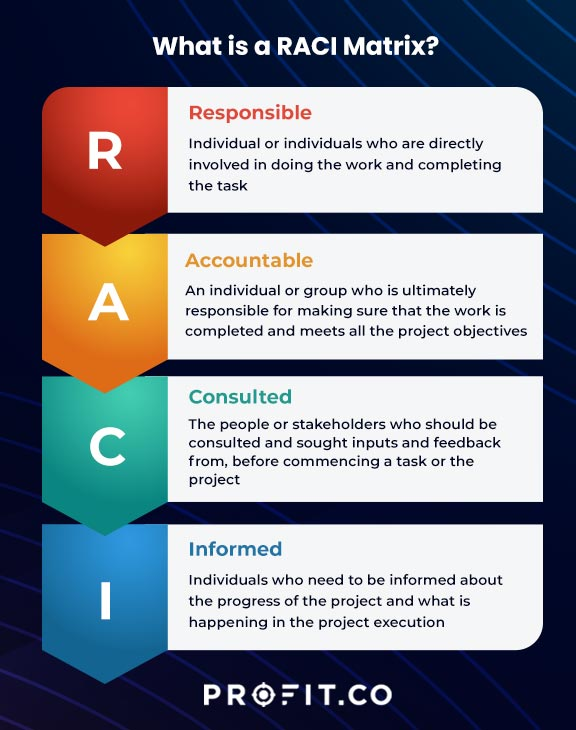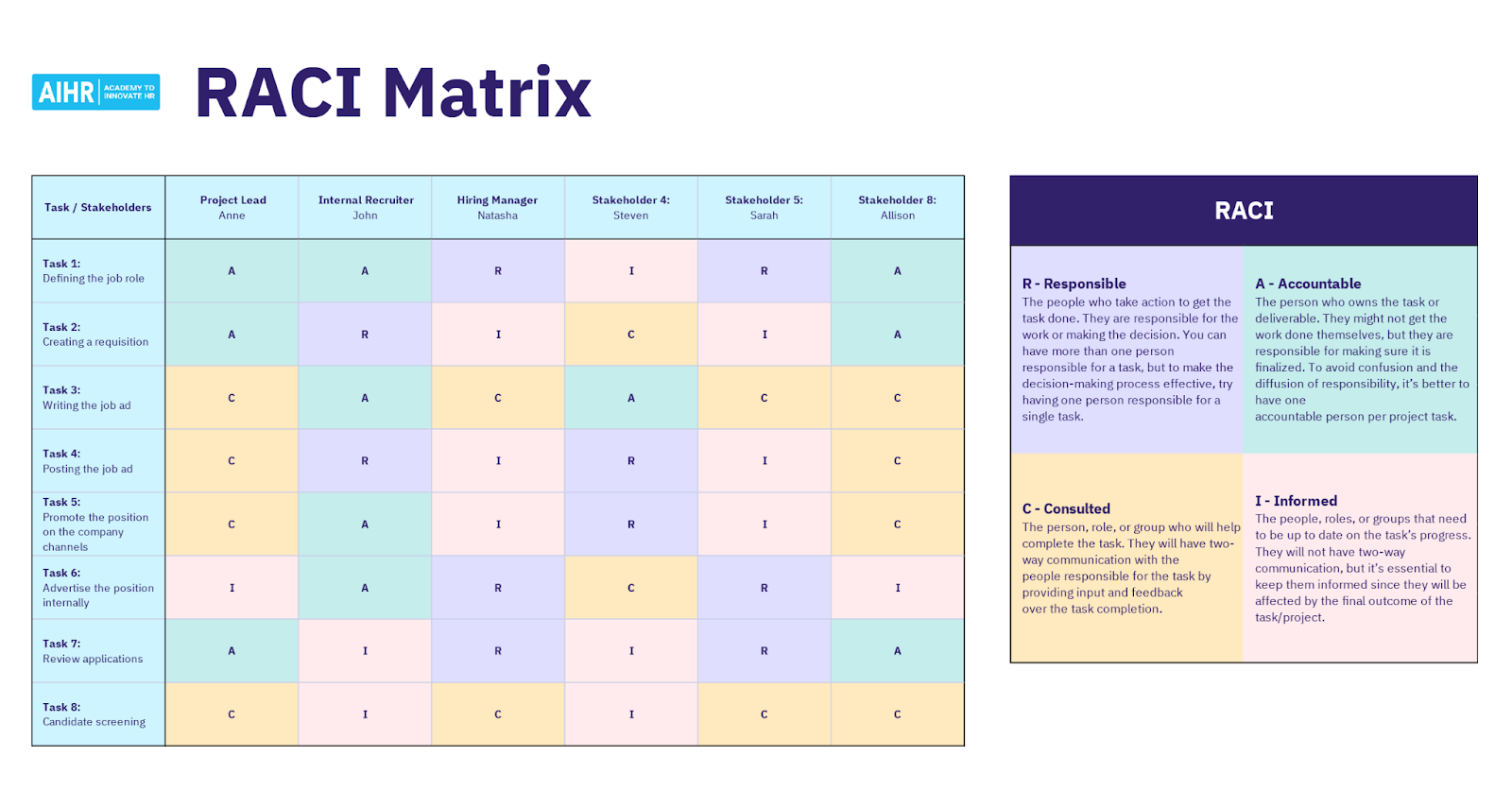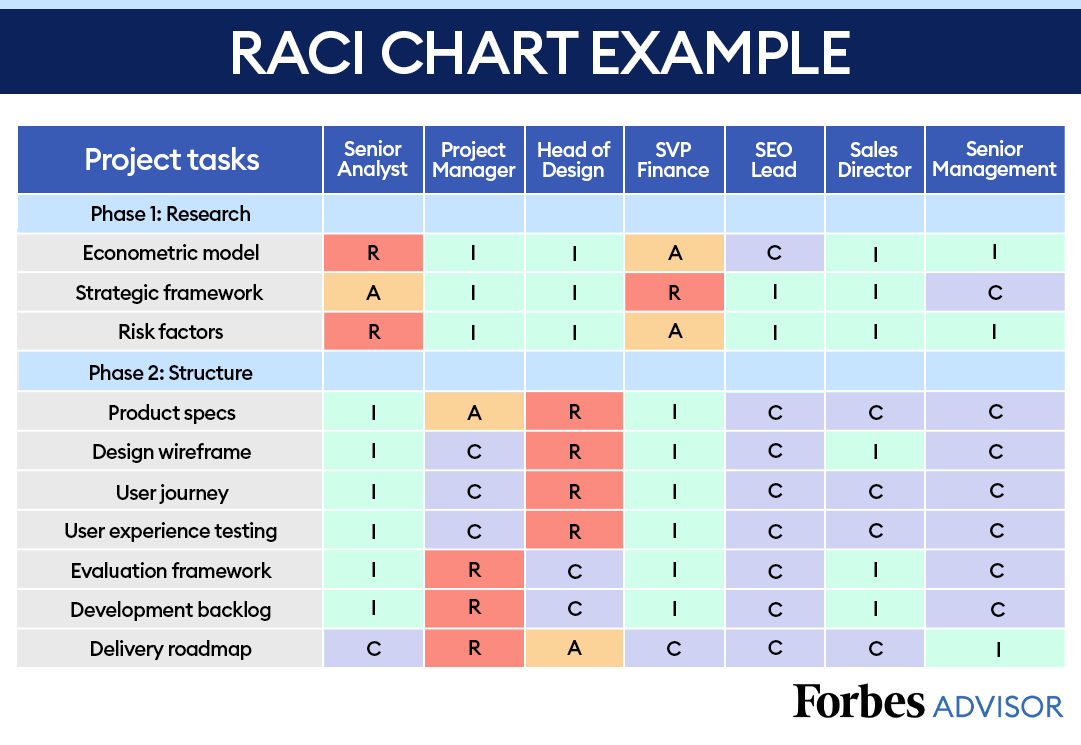A RACI chart, or RACI matrix, is a widely used tool for project managers that aims to clarify the roles and responsibilities of a project clearly. The RACI model is the abbreviation of Responsible, Accountable, Consulted, and Informed—namely, of the four basic project task roles a team member may occupy. Such will enhance the communication on a project and reduce the chance of miscommunication leading to error between the various project stakeholders. A well-arranged process of planning of the project ensures that all the roles and responsibilities of direct employees are well known. Thus, it is likely that a project will be more fully and correctly undertaken.
Introduction to RACI Chart
A RACI Chart, often also called a RACI matrix, represents a prevailing tool employed by project managers in the course of project planning. This chart illustrates the roles of employees and the relevant responsibilities of implementing certain project tasks. The RACI model is an abbreviation for Responsible, Accountable, Consulted, and Informed. Each of these categories of a RACI model describes a relevant level of task involvement. This clarification of responsibilities promotes high-level project communication among the project stakeholders. Thus, the RACI Chart is a relevant part of project management that guarantees a smooth workflow and effective implementation of project roles and responsibilities.
What is a RACI Chart?
A RACI Chart, commonly known as a RACI matrix, is a project management tool specifically designed to clarify roles and responsibilities of project personnel during the course of a project. This model gives an easy approach to identifying and representing the roles of multiple project stakeholders in the performance of project assignments. The abbreviation RACI stands for Responsible, Accountable, Consulted, and Informed. Project managers can often use the RACI chart during the process of project planning to enhance project communication and, at the same time, reduce confusion. The RACI model defines the responsibilities of employees. Therefore the approach ensures more significant improvements in the clarity of roles in the project.
The Importance of RACI Chart in project management
RACI Chart is an indispensable tool in project management. In a way, it defines the roles and responsibilities of employees. In that regard, it enhances the aspect of project communication. The RACI matrix or an acronym for Responsible, Accountable, Consulted, Informed, is a chart that defines the project activities. In other words, it defines carefully people who are responsible for action execution, people who are accountable for action implementation, those who need to be consulted on its process, and people who need to be informed about its progress. It is a tool of the employee that a project manager will use in the process of project planning to ensure that all is clear and that there is no role confusion amongst the project stakeholders. The tool used in the definition of project roles and responsibilities goes a long way in making sure that projects are completed successfully.
The Importance of Bonsai in project management
Bonsai is important for project management because it provides a centralized platform that integrates various aspects of project work, enabling teams to deliver projects efficiently and effectively while maintaining high standards of quality and collaboration.

In conclusion, Bonsai enhances project collaboration by providing a suite of tools designed to facilitate communication, manage resources, share documents, and track project progress. It's an invaluable asset for teams looking to optimize their workflow and achieve their project goals efficiently.
Understanding the components of a RACI Chart

A RACI Chart, where the structure appears, is a project management visualization that is used to allocate the roles within a project or organizational processes among other stakeholders. The set roles are defined through four categories: Responsible, Accountable, Consulted, and Informed, thereby creating the RACI model.
In a RACI matrix, "Responsible" denotes the person responsible for carrying out the activities; "Accountable" denotes the person assigned to ensure that the activities are properly and fully carried out; "Consulted" denotes the stakeholders who are supposed to provide input to the project; and "Informed" denotes the recipients who are supposed to be informed of the results. Project managers often use such matrices to structure project planning activity and in effectively communicating a project.
Defining roles in a RACI Chart
One of the most important steps that should be considered while creating a RACI matrix is role definition. At this stage, a project manager must clearly establish the employee role assignments and make sure that everyone is clear about their project roles and responsibilities. The RACI model has defined four basic roles: Responsible, Accountable, Consulted, and Informed.
Accountable is the person who will sign off the work; Consulted entails those from whom opinions are in the line of duty; and Informed refers to those who are kept in the loop of the progress. This framework supplements the project management process in an essential way in that it guarantees smooth communication throughout the project at every stage of work, gives clear project tasks, and ensures proper engagement with every critical stakeholder involved in the project.
A clear RACI chart in the project planning process gives a clear understanding of the responsibility of each person, thus resulting in an easy workflow and productivity.
Understanding the four responsibilities
Understand the Four Responsibilities in the RACI model: 'Responsible' refers to the employees that will perform the tasks of the project. 'Accountable' refers to people – like project managers – owning the final result. 'Consulted' refers to people outside the project stakeholders but that need to be embraced in the project planning process – in other words, the people that will be affected by the result. 'Informed' refers to everyone towards whom there should be communication regarding the project activities and decisions.
Knowing such responsibilities helps to clear employee roles and forms a RACI matrix, which is vital in communicating information in a project.
How to create a RACI Chart

Creating a RACI chart is an integral part of the project planning process for project managers. The RACI matrix aids in clarifying the roles and responsibilities of project stakeholders, fostering better project communication. To create a RACI chart, you first need to list all project tasks on the left column. Then, across the top, list the employee roles involved in the project. In the intersection of the tasks and roles, assign one of the RACI model roles: Responsible, Accountable, Consulted, Informed.
This tool enables the project managers to decipher who is responsible for what, with each letter in the RACI acronym fulfilling a specific part: Responsible for carrying out an action, Accountable for the completion of the task, Consulted before a decision or action is taken, and Informed of decisions and actions.
Identifying the tasks and roles
In project management, the RACI matrix is a crucial tool for defining project roles and responsibilities. This model, which stands for Responsible, Accountable, Consulted, and Informed, provides a clear delineation of tasks and roles to ensure smooth project communication and execution.
Typically, project managers utilize the RACI model in the project planning process, explicitly establishing who is Responsible for completing project tasks, who is Accountable for the overall deliverables, who needs to be Consulted, and who should remain Informed.
This approach helps to clarify employee roles and responsibilities, promoting efficient cooperation among project stakeholders.
Assigning the responsibilities
The project managers exhibit vital value in the project planning process by defining the project roles and responsibilities. One effective method they can use is the RACI matrix. The RACI model provides a clear framework to assign employee roles by highlighting who is Responsible, Accountable, Consulted, and Informed for each project tasks improving overall project communication.
To ensure efficient execution:
- Responsibilities should be clearly communicated to all project stakeholders.
- Each employee should understand their roles and responsibilities in the project.
- The RACI matrix should be used actively throughout the project to avoid any confusion or miscommunication.
Validating the RACI Chart
In the project management stage, project managers often use the RACI matrix to delegate employee roles and responsibilities. The RACI model is an efficient project planning process tool designed to enhance project communication. It clearly defines project tasks, ensuring everyone involved in the project understands their role.
Each letter in RACI stands for Responsible, Accountable, Consulted, and Informed. The chart offers a clear visual diagram of who is responsible for each task involved in the project, who is accountable, who needs to be consulted, and who should be informed. It helps project stakeholders align their actions and contributions towards achieving project goals.
Benefits of using a RACI Chart
The use of a RACI matrix provides numerous benefits in project management, specifically in delineating project roles and responsibilities. By defining who is Responsible, Accountable, Consulted, and Informed for each project task, it significantly streamlines the project communication process.
This is hugely beneficial to project managers, as it can clarify employee roles, eliminate confusion, and ensure proper distribution of duties. Furthermore, it can aid the project planning process by providing a clear visual of tasks and responsibilities, giving project stakeholders a comprehensive understanding of the project's structure.
Improving communication and collaboration
Project managers can use the RACI matrix to improve communication and collaboration among project stakeholders. This model helps in defining project roles and responsibilities, clarifying who is Responsible, Accountable, Consulted, and Informed for each project task.
Every project planning process should incorporate the RACI model to map out employee roles and their responsibilities. This will enhance project management by fostering clear project communication.
Moreover, the RACI matrix plays a key role in defining project tasks, thereby eliminating any possible confusion among team members and promoting efficient collaboration.
Eliminating role confusion
Role confusion presents significant challenges to project managers, often compromising the project planning process. One effective tool for eliminating such confusion is the RACI Matrix. RACI stands for Responsible, Accountable, Consulted, and Informed - four distinct roles an individual may play in a particular task or decision.
The RACI model aids in clearly specifying employee roles and responsibilities, which then enhances overall project communication. By mapping project tasks to specific stakeholders, project managers can minimize confusion and foster a more streamlined project execution.
In conclusion, the RACI matrix is essential in defining project roles and responsibilities thus enhancing project management.
Enhancing project efficiency
Project managers enhance project efficiency by defining clear project roles and responsibilities using the RACI matrix. The RACI model details who is Responsible, Accountable, Consulted, and Informed, improving project management and communication. It ensures no overlapping responsibilities and boosts the project planning process.
Identification of project tasks and stakeholder integration is critical. The project stakeholders understand their roles better, fostering a smooth project communication. By doing this, they optimize the employee roles and clarify their project roles profile.
Project managers can also use the RACI matrix to evaluate employee roles within the project, ensuring a more effective utilization of resources and increased project efficiency.
Common mistakes to avoid when using a RACI Chart
When using a RACI matrix in the project planning process, project managers must avoid certain pitfalls. One mistake is to assign too many responsibilities to a single project role. This leads to overlap and possible conflict, as well as overwhelming the individual. Secondly, failing to clearly lay out roles using the RACI model can cause confusion about who is responsible for what. Lastly, poor project communication can result in stakeholders being uninformed about their roles, or the employee roles can be misunderstood.
Following these guidelines can make the use of RACI charts smoother and more effective, leading to well-defined project tasks and clear accountability. Avoiding these common mistakes is crucial for successful project management.
Overcomplicating the Chart
Project managers often use the RACI model in the project planning process to clarify employee roles and their responsibilities. However, they tend to overcomplicate the RACI matrix, making it difficult for project roles and responsibilities to be understood.
This results in ineffective project communication among project stakeholders. Instead of providing clarity on project tasks, the matrix becomes overwhelming and counterintuitive.
- Responsible
- Accountable
- Consulted
- Informed
should be clearly defined to avoid confusion.
When used correctly, the RACI matrix can streamline project management by illustrating who is responsible, accountable, consulted, and informed for each specific task.
Ignoring the input of team members
One major oversight in project management is the disregard for input from team members. As defined in the RACI matrix, every employee has distinct roles and responsibilities, which informs the overall project planning process. However, when project managers fail to acknowledge the importance of their contributions, a gap in project communication arises
Project managers must remember the key principles of the RACI model - Responsible, Accountable, Consulted, Informed. Concrete project roles and responsibilities must be assigned, including which project tasks each member is accountable for. Inclusion of all project stakeholders promotes a healthy, efficient work environment, ultimately solidifying the success of a project.
Using RACI Chart with project management tools

The RACI matrix is a nifty chart that project managers whip out to assign tasks and make sure everyone knows who’s doing what in the project planning shindig. It’s like a who’s who for projects, with RACI standing for Responsible, Accountable, Consulted, and Informed, cutting through the noise and keeping everyone on the same page. This handy tool lays out the tasks and pins down:
- Who’s got the ball (‘Responsible’),
- Who’s the big cheese (‘Accountable’),
- Who’s in the loop (‘Consulted’), and
- Who’s in the know (‘Informed’).
By mapping out who’s who in the zoo, RACI charts are the secret sauce to driving efficiency and getting things done without stepping on each other’s toes.
Integrating RACI Chart with Trello
Slide the RACI matrix into Trello, and you’ve got yourself a smooth-sailing project management process. It’s like putting names to faces for each task, so there’s no guesswork about who’s doing what. This means every team member has a clear-cut role, which is key to keeping the project chatter clear and the team in sync. When you’re knee-deep in project planning, Trello’s RACI model is your go-to for spelling out who’s responsible for what. It’s all about making sure everyone’s clued in on their gigs, paving the way for teamwork that’s as slick as a whistle.
Utilizing RACI Chart in Asana
Asana and the RACI model go together like peas and carrots for project managers. It’s a dynamic duo that brings clarity to who’s supposed to do what. Asana’s layout lets you tie tasks to folks or teams with no muss, no fuss. With the RACI chart in Asana, you’re looking at communication that’s as clear as day. It’s about lining up tasks with the right people, so everyone’s singing from the same hymn sheet. Plus, Asana makes the whole project planning dance smoother, with everyone getting the picture of their roles, which is a big win for project success.
Conclusion: maximizing the potential of RACI Chart
Maximizing the potential of raci chart Project managers, listen up! You can really make the most of the RACI chart by spelling out who’s supposed to do what. It’s all about keeping the project talk efficient and making sure no one’s left scratching their head about their tasks. With the RACI lineup - Responsible, Accountable, Consulted, Informed - you’re streamlining the whole project planning routine. It’s a game-changer for dodging mix-ups and making sure everyone’s clear on their part in the project playbook. So yeah, the RACI matrix is pretty much a project manager’s best friend.






